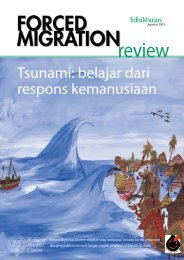FMR 42 full issue pdf - Forced Migration Review
FMR 42 full issue pdf - Forced Migration Review
FMR 42 full issue pdf - Forced Migration Review
You also want an ePaper? Increase the reach of your titles
YUMPU automatically turns print PDFs into web optimized ePapers that Google loves.
<strong>FMR</strong> <strong>42</strong><br />
Sexual orientation and gender identity and the protection of forced migrants 47<br />
efforts must be made to build bridges between<br />
LGBT refugees and other immigrants from<br />
their countries of origin. With increased<br />
support, improved access to services and new<br />
opportunities to become part of a community,<br />
LGBT refugees will be able to carve out<br />
new lives and pursue new possibilities.<br />
Scott Portman SPortman@heartlandalliance.org<br />
is Senior Technical Advisor, and Daniel Weyl<br />
DWeyl@heartlandalliance.org is Coordinator,<br />
Rainbow Welcome Initiative, with Heartland<br />
Alliance International. www.heartlandalliance.org<br />
Heartland Alliance International’s Rainbow<br />
Welcome Initiative is a two-year technical<br />
assistance programme for US refugee resettlement<br />
agencies and torture treatment programmes<br />
intended to improve services for LGBT refugees and<br />
asylum seekers. www.rainbowwelcome.org<br />
1. Gates, Gary J (2011) How many people are lesbian, gay, bisexual, and<br />
transgender? The Williams Institute, University of California at Los<br />
Angeles http://tinyurl.com/Williams-Inst-Gates-April2011<br />
LGBTI migrants in immigration detention<br />
Shana Tabak and Rachel Levitan<br />
As states increasingly use detention as a means of controlling migration flows, sexual minority<br />
migrants find themselves in detention facilities where they may face multiple violations of<br />
their human rights.<br />
Increasingly, states detain irregular migrants as<br />
a means, they believe, to control migration flows<br />
and deter further irregular migration. Despite<br />
this trend, detention has not deterred migrants<br />
from crossing borders. Furthermore, conditions<br />
in immigrant detention facilities have been<br />
widely criticised as violating international law.<br />
Sexual minorities in detention often face<br />
social isolation, physical and sexual violence<br />
directed at them because of their gender<br />
identity, and harassment by both facility<br />
staff and other detainees. In most prison<br />
settings, sexual minorities face a heightened<br />
risk of targeted physical and sexual violence.<br />
Transgender women 1 are particularly<br />
vulnerable to this abuse because they are<br />
usually housed with men; in the US, for<br />
instance, they are thirteen times more likely to<br />
be sexually assaulted than other detainees.<br />
2. www.dhs.gov/xlibrary/assets/statistics/publications/ois_rfa_fr_2011.<strong>pdf</strong><br />
3. The refugee estimates are based on information from Resettlement<br />
Service Centers (RSCs) in East Africa, the Middle East and Asia, where<br />
the majority of refugees are processed. The asylum seeker estimates<br />
are based on the National Immigrant Justice Center (NIJC) informal<br />
survey of other programmes specialising in LGBT asylum seeker legal<br />
representation as well as members of the American Immigration Law<br />
Association who handle these cases in private practice.<br />
4. For information on best practices on HIV+ refugee resettlement see<br />
www.refugeehealthta.org/webinars/hivaids/hiv-webinar-062011/ and<br />
www.refugees.org/resources/for-service-providers/hiv-aids.html<br />
5. For a description of an integrated model for torture treatment, see<br />
www.heartlandalliance.org/kovler/news/caringfortorturesurvivors.<strong>pdf</strong><br />
6. The Organization for Refuge, Asylum and <strong>Migration</strong> (ORAM) has<br />
piloted a programme in San Francisco in which LGBT refugees and<br />
asylum seekers are matched with community volunteers who provide<br />
housing, social support and assistance in finding employment. See<br />
www.oraminternational.org/<br />
7. Now widely recognised as the symbol of the international LGBT<br />
movement.<br />
8. See Heartland Alliance International’s resettlement manual Rainbow<br />
Response: A Practical Guide to Resettling LGBT Refugees and Asylees at:<br />
http://tinyurl.com/HAI-Rainbow-Response<br />
9. HAI’s Marjorie Kovler Center has run a torture survivor support<br />
and cooking group for several years, in which torture survivors gather<br />
monthly to cook foods from their countries of origin, share dinner and<br />
participate in social activities.<br />
LGBTI detainees are often placed in<br />
‘administrative segregation’ in response to<br />
complaints of sexual or physical violence or as<br />
a preventive measure. Although segregation<br />
may seem to be the only available means of<br />
protecting sexual minority migrants from<br />
violence, in many detention centres it is<br />
indistinguishable from solitary confinement,<br />
involving confinement for 23 out of 24 hours<br />
a day in a tiny cell with extremely limited<br />
access to the outdoors, exercise or other<br />
people. This practice can lead to severe mental<br />
health after-effects and may exacerbate Posttraumatic<br />
Stress Disorder (PTSD) or other<br />
conditions developed in response to violence<br />
in the country of origin or during migration.<br />
(In some cases, LGBTI detainees may selfisolate<br />
so as to avoid stigmatisation by refugees<br />
from their countries of origin.) Such solitary<br />
confinement is held by international human




